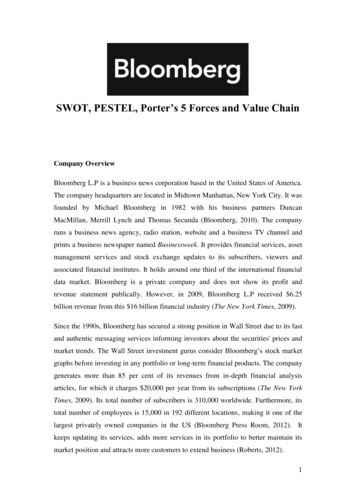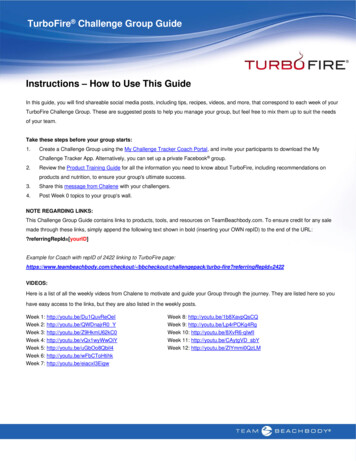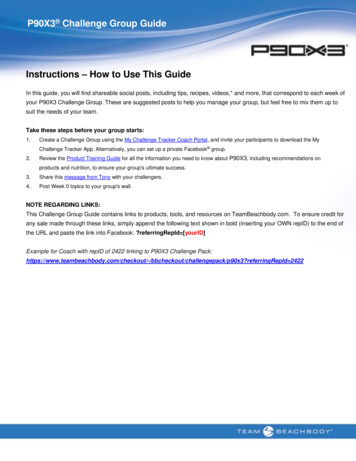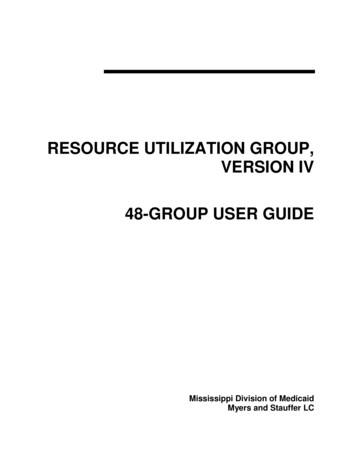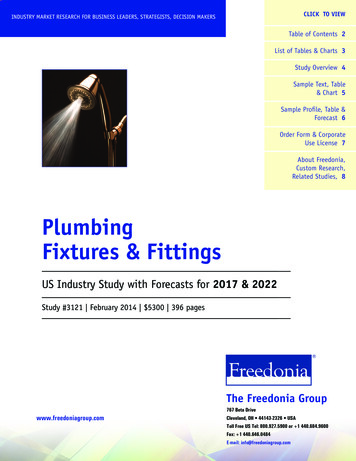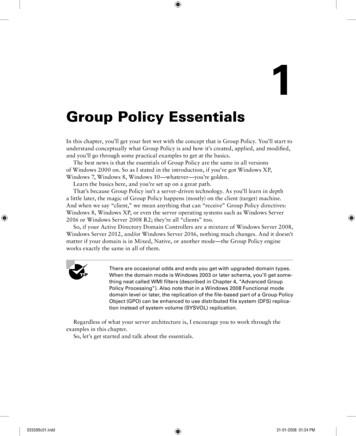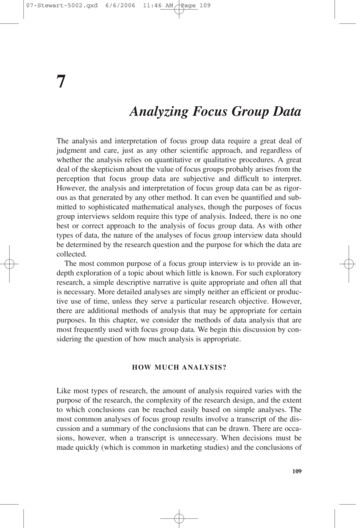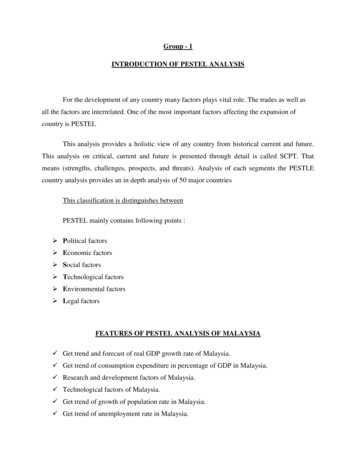
Transcription
Group - 1INTRODUCTION OF PESTEL ANALYSISFor the development of any country many factors plays vital role. The trades as well asall the factors are interrelated. One of the most important factors affecting the expansion ofcountry is PESTELThis analysis provides a holistic view of any country from historical current and future.This analysis on critical, current and future is presented through detail is called SCPT. Thatmeans (strengths, challenges, prospects, and threats). Analysis of each segments the PESTLEcountry analysis provides an in depth analysis of 50 major countriesThis classification is distinguishes betweenPESTEL mainly contains following points : Political factors Economic factors Social factors Technological factors Environmental factors Legal factorsFEATURES OF PESTEL ANALYSIS OF MALAYSIA Get trend and forecast of real GDP growth rate of Malaysia. Get trend of consumption expenditure in percentage of GDP in Malaysia. Research and development factors of Malaysia. Technological factors of Malaysia. Get trend of growth of population rate in Malaysia. Get trend of unemployment rate in Malaysia.
Get trend of savings and consumption as well as investment and expenditure inpercentage in GDP of Malaysia.BENEFITS OF PESTEL ANALYSIS IN MALAYSIA Political section on Malaysia provides get the information about the whole political systemgovernors indicators and all key figures in the country. From economic section we get all outlines of the economics stories of the country and isprovides balanced between assessments on core macro economical issues. In social section of Malaysia country it enables understanding of consumer demographicsby the income distribution, rural market and urban market segmentation health care andeducation scenario in country. Technological section provides all strategies information and communication of thetechnology, technological laws and policies, gapes patterns data also. In legal section we can get information about legal structure, corporate laws, business setupprocedures and tax informationTYPICAL PESTEL FACTORS TO CONSIDER INCLUDE:FactorCould include:Politicale.g. EU enlargement, the euro, international trade, taxation policyEconomice.g. interest rates, exchange rates, national income, inflation, unemployment,Stock MarketSociale.g. ageing population, attitudes to work, income distributionTechnologicale.g. innovation, new product development, rate of technological obsolescenceEnvironmentale.g. global warming, environmental issues
Legale.g. competition law, health and safety, employment lawTHIS VERSION OF PESTEL ANALYSIS IS CALLED LONG PESTEL. THIS ISILLUSTRATED BELOW:POLITICALLOCALNATIONALGLOBALProvision of servicesUK government policy World tradeby local councilon subsidiesagreements e.g. furtherexpansion of the EUECONOMICLocal incomeUK interest ratesOverseas economicgrowthSOCIALLocal populationDemographic changegrowth(e.g. ageingMigration flowspopulation)TECHNOLOGICAL Improvements in local UK wide technologytechnologies e.g.e.g. UK online services technologicalavailability of Digitalbreakthroughs e.g.TVinternetENVIRONMENTAL Local waste issuesLEGALInternationalUK weatherGlobal climate changeLocal licenses/planning UK lawInternationalpermissionagreements on humanrights or environmentalpolicy
However, the relative importance of economic factors compared to other factors willdepend on the particular position of a business. Exchange rate fluctuations may be criticallyimportant to a multinational but less significant to a local window cleaner.Group - 2Present Trade Relations“One of the wealthiest best developed countries in south East Asia”In 1957, the Federation of Malaya gained its independence from the British colony.In1963, together with the British colonies of Sabah and Sarawak, Malaysia comes into being as anindependent federation.The Federal government has considerable power over the stategovernment of the 11 states of peninsular Malaysia.Sabah and Sarawak however enjoy rights thatthe other states do not, rights which are derived from agreements reached when Malaysia wasformed.On 2 April 2009, NajibTunRazak, the son of Tun Abdul Razak, Malaysia‘s second primeminister, became prime minister in his own right. Najib successfully overcame frictions withinthe ruling BN and is strongly supported by his own party, the United Malays NationalOrganization (UMNO).Malaysia‘s economic transformation from 2009 to 2011 shows more positive signs thandoes its political development. The country was strongly affected by the global financial crisis,but its economy recovered and gained strong new momentum in 2010. On 30 March 2010, PrimeMinister Najib unveiled a so-called New Economic Model (NEM), which many observers hopedwould be more need- and merit-based and less focused on race.The goals of the NEM are to allow Malaysia to double its per capita income by 2020 andbecome more competitive, more market-driven and more investor-friendly. As a road maptoward these goals, the government
There are 13 states: 11 of which are in peninsular Malaysia and 144 Local Authorities.SocialEconomic planning system at the national level.Currently socioeconomic development inMalaysia is being guided by vision 2020 and Malaysia plan.“Transform Malaysia into a high-income economy through quality growth by 2020”The Malaysia plan sets macroeconomic growth goals, outlines the scale and distributionof public sector development projects, and lays out guidelines for the public sectors.The plan is based on 10 ideas: Internally driven, externally aware, Leveraging ondiversity internationally, Transforming to a high income nation through specialization,Productivity-led growth and innovation, Nurturing, attracting and retaining top talent., Ensuringequality of opportunity and safeguarding the vulnerable, Concentrated growth, inclusivedevelopment, Supporting effective and smart partnerships, Valuing environmental friendliness,Government as competitive corporation.Malaysia, a middle-income country, has transformed itself since the 1970s from aproducer of raw materials into an emerging multi-sector economy. Under current Prime MinisterNAJIB, Malaysia is attempting to achieve high-income status by 2020 and to move farther up thevalue-added production chain by attracting investments in Islamic finance, high technologyindustries, biotechnology, and services.The NAJIB administration also is continuing efforts to boost domestic demand andreduce the economy's dependence on exports. Nevertheless, exports - particularly of electronics,oil and gas, palm oil and rubber - remain a significant driver of the economy. As an oil and gasexporter, Malaysia has profited from higher world energy prices, although the rising cost ofdomestic gasoline and diesel fuel, combined with strained government finances, has forcedKuala Lumpur to begin to reduce government subsidies.In 2007, the economy of Malaysia was the 3rd major economy in South East Asia and28th largest economy in the world by purchasing power parity with gross domestic product for2008 of 222 billion Information/Data on Malaysia's Economic System, a combination of privateenterprise and deeply managed public sector, has sent amazing record of 8%-9% averageprogress in 1987-92. This progress has resulted in a significant discount in scarcity with a growth
rate of 5% to 7% since 2007 In 2010, GDP per capita (PPP) of Malaysia stands at US 14,700. In2009, the PPPGDP was US 383.6 billion, and the PPP per capita GDP was US 8,100.Economic Transformation Programe was launched in preceding year. The goal is toelevate the countries per capital GNI From the 6700 recorded in 2010 to a level exceeding 15000 by 2020. In order for this goal to be achieved a targeted annual growth of 6% in GNIover the next decade has been set as an objective.The starting point of the ETP was to focus on specific factors and areas of the economyto drive such changes the 12 areas identified on the basis are: Agriculture, Business Service,Communication content and infrastructure, Education, Electronic and Electrical, FinancialServices, Greater Kuala Lumpur/Klang Valley, Health Care, Oil, Gas, and Energy, Palm Oil,Tourism, Wholesale and Retail.The ETPs have been identified to drive the growth in the financial service sectors are: Becoming the indisputable global hub for Islamic finance. Insuring up to at least 75% of the Malaysian population by 2020. Developing regional bank Champions.Rubber was known to the indigenous people of the Americas long before the arrival ofEuropean explorers. In 1525, Padre d'Anghieria reported that he had seen Mexican tribes peopleplaying with elastic balls. The first scientific study of rubber was undertaken by Charles de laCondamine, when he encountered it during his trip to Peru in 1735. A French engineer thatCondamine met in Guiana, Fresnau studied rubber on its home ground, reaching the conclusionthat this was nothing more than a "type of condensed resinous oil".The first use for rubber was an eraser. It was Magellan, a descendent of the famousPortuguese navigator, who suggested this use. In England, Priestley popularized it to the extentthat it became known as India rubber. The word for rubber in Portuguese - borracha - originatedfrom one of the first applications for this product, when it was used to make jars replacing theleather borrachas that the Portuguese used to ship wine.
Natural rubber is a solid product obtained through coagulating the latex produced bycertain plants, particularly the Brazilian rubber-tree (Hevea Brasiliensis). This raw material isusually tapped from the rubber tree, which is native to Amazonia. Although there a large numberof species that exude secretions similar to latex when the bark is cut, only a few producesufficient quantities of a quality adequate for exploitation on economic bases.The output of Amazonia reached 42,000 tons a year, with Brazil dominating the globalnatural rubber market. This euphoria lasted through to 1910, when the situation began to change:rubber exports began to appear on the market from British Colonies, and Brazil was unable towithstand this fierce competition.In the late 1920s, Brazil was still attempting to catch up this lost ground with the help ofan unexpected partner: US industrialist Henry Ford, who had developed a new scheme - theproduction line - that was to change the face of industry for ever, and at that time accounted for50% of the world's vehicle output. In order to loosen the grip of the British Colonies in SoutheastAsia on the rubber market - the precious raw material for making tires - Ford planted no less than70 million rubber tree seedlings in an area covering one million hectares in Para State.The drop in natural rubber production in Brazil coincided with World War I (1914-1918),triggering the need for lower-cost products with steadier supplies in order to manufacture tires.The pressures imposed by the conquest of the plantations of Asia by the Japanese prompted thedevelopment of a rubber that was able to meet the extraordinarily high demands of the troops atthat time, although its structure differed somewhat from its natural counterpart.Each Sherman tank contained twenty tons of steel and half a ton of rubber. Each warshipcontained 20,000 rubber parts. Rubber was used to coat every centimeter of wire used in everyfactory, home, office and military facilities throughout the USA. There was no syntheticalternative. Looking at all the possible sources, at normal consumption levels, the nation hadstocks for around one year. And these reserves also had to supply the largest and most criticalindustry in the history of the world during a time of rapid expansion: the arms segment.The US industrial sector had never been called upon to shoulder such a massive task,achieving so much so quickly. The engineers were given just two years to reach this target. If thesynthetic rubber program failed, the capacity of the USA to fight the war would be blunted. This
US drive was to help spread synthetic rubber throughout the world's market, even in Brazil as itstrove to consolidate its industrial park during the post-War years.The natural rubber production in Malaysia is declining recent years. The statement ofsupply-demand balance of natural rubber in ANRPC member countries during 2009 state thatMalaysia‘s total supply is 1751000 tonnes while total demand is 1765000 tonnes. There is anatural rubber demand surplus of 14000 tones. Natural rubber will remain in tight supply nextyear as yields from aging trees decline and output glows slow, said the Association of NaturalRubber Producing Countries. The association represents Cambodia, China, India, Indonesia,Malaysia, Papua New Guinea, Philippines, Singapore, Sri Lanka, Thailand and Vietnam.The Malaysian rubber industry was one of the major sources of income of the country inpast decades. Later on, the production of rubber has been declining and some investors evenlabeled rubber industry as a sunset industry. Somehow it is still early to predict the future ofMalaysia rubber industry. However, currently the rubber industry is in its positive trend and thereare some other positive signs of the future. Therefore, we believe that the future of Malaysianrubber industry is bright.Malaysia is a dynamic country which is constantly evolving. Being a middle-incomecountry, Malaysia has transformed itself since the 1970s from a producer of raw materials into anemerging multi-sector economy spurred on by high technology, knowledge-based and capitalintensive industries.Malaysia‗s Economic Performance ranking improved to 7th place out of 59 economiesthis year compared with 12th position in 2007.1 It is one of the 20 largest trading nationsworldwide and was headed of Taiwan, Sweden, Canada, Australia, the United Kingdom andSwitzerland.2 The World Competitiveness Yearbook 2011 Report released by the Institute forManagement Development (IMD) continued to rank Malaysia as among
This analysis provides a holistic view of any country from historical current and future. This analysis on critical, current and future is presented through detail is called SCPT. That means (strengths, challenges, prospects, and threats). Analysis of each segments the PESTLE country analysis provides an in depth analysis of 50 major countries
